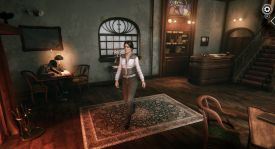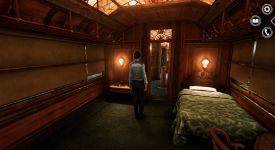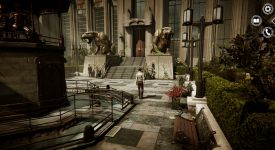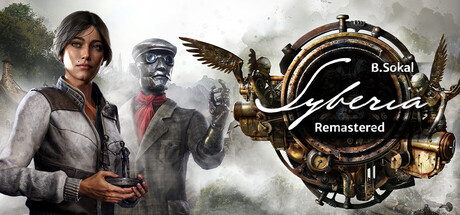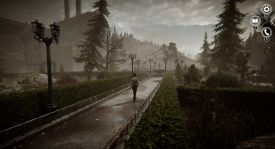|
By flotsam
Syberia - Remastered
Microids
Hard on the heels of the
recently reworked Amerzone, we now have this, the next game released by
Benoît Sokal back in the day (2002) and the first of what became a
series with three sequels.
Like Amerzone, I played the
original back then and remember it positively, but I haven’t played it
since and apart from some general recollections the detail escapes me.
This review is therefore based solely on my experience playing this
version.
The game revolves around Kate
Walker, a lawyer despatched to the European town of
Valadilène, a clockpunk out-of-the-way
place, to secure the purchase of the Voralberg automaton factory. An
untimely death adds an unforeseen complication and sets Kate off on a
journey the likes of which she could never have expected.
The game plays in the
third-person and is entirely point and click. It looks good, if a little
flat texturally and chromatically, but the detail is impressive. There
is sufficient movement in the world to help bring it to life, and in
conjunction with the free movement and the dynamic camera, it definitely
felt like somewhere I was, not somewhere I was watching.
That was further helped by
turning off the music. It never let up, and well before I had left
Valadeline its relentless loop had worn me out. Whilst there isn’t a lot
of ambient sound, what there is was more than enough to provide the
‘soundtrack.’ What’s more, music still plays under many of the cutscenes,
providing what I thought was a perfect balance.
The camera can’t be controlled,
and might frustrate at times. It pivots and swings, sometimes pulling
back, sometimes moving in close, and might watch Kate explore from
behind or from in front. While generally I thought it worked well, there
were times when my exploration was a little clumsy and even a tad
complicated by how I was able to view the game world.
The camera is at its best in
large locations, adding an almost cinematic vibe to Kate’s endeavours.
The initial main street of Valadilène is a good example, the scene
shifting and moving as Kate explores. There is rarely an occasion on
which what you can see on screen is all there is, and Kate’s
perambulations will push and pull the scenes in many directions.
Hotspots will become visible as
Kate approaches, and click to utilise. You don’t choose what to do at
each hotspot, engaging in whatever the little pop up label says to do.
It might be e.g., interact or take or go up, place if an inventory item
is needed, or speak if a character is involved. Interact might pull you
further in (e.g., close up on a desktop) where you might be able to
further explore or engage.
If an inventory item is needed,
a little inventory window will open, enabling you to cycle through each
item to determine which item to try. All up, interacting with the world
is efficient and I thought it worked well.
Kate has a phone, which is a key
part of a couple of puzzles but is largely the source of people from her
personal and professional life calling her for a ‘chat.’ While it
fleshes out who Kate is, and plays into the journey she is on and the
choices she ultimately makes, it is somewhat soapy and a touch clichéd.
Puzzling is a mix of inventory
conundrums and straight out puzzles, and are a mix of the seemingly
mundane (e.g., get a permit stamped) to the much grander (e.g., restart
a factory, activate an airship). You will find things, fix things and
blow things up. It isn’t difficult, but making a cocktail (something I
should have excelled at) tripped me up and the less said about finding
the tossed crank the better.
Certain conversations are
necessary to trigger progression. A topic tree will pop up when speaking
to a character, and you simply choose which one to ask about. Or just
choose the one marked ‘mission,’ which will mean you miss out on some
interesting banter and a degree of depth but will certainly cut to the
conversational chase.
There is a fair bit of contrived
back and forth, and a bit more likely the result of wondering what to do
next. That can be helped by playing in Story mode, which will put
objectives into your journal, or play in Adventure mode to be more on
your own. I toggled between them to get a sense of both, and Story is
certainly a more guided experience.
You will get to leave Valadilène,
via a wind-up train helmed by Oscar, a most excellent if punctilious
automaton. The additional locations you visit are few, but each is
varied and elaborate. Contrast the the university at Barrockstad, its
entrance flanked by a group of mammoths and its station home to lush
gardens and an exotic aviary with the ‘worn out’ snow-swept span of
Aralbad. The grimy mining hub that is Komkolzgrad is different
again. I was impressed by all of them.
Kate walks by default but
double-clicking will get her to run, and holding down the mouse will
cause her to follow it. Top right are icons for your phone, your journal
(which includes your documents and inventory items) and the settings
menu. The game exclusively saves automatically, but you can force a save
by changing locations (e.g., enter or exit a building) and while you can
have three games on the go at any one time, each has only a single save
point. So there is no reloading earlier progress, although you can
restart a Chapter should you wish to.
What else? Some of the cutscenes
haven’t been remastered and are somewhat jarring as a result, and Kate’s
facial expression can border on the scary. The voice acting, especially
that of Kate and Oscar, is excellent. Sound dropped out in the
un-remastered cutscenes, but apart from that issue the game ran
flawlessly. There are references to the earlier Amerzone. The game sets
up for a sequel and a dozen hours or so should see you through.
In conclusion, whilst not
everything hit the mark, I enjoyed engaging again with Kate and Oscar.
I played on:
Lenovo Thinkpad X1 Carbon Gen 13
Intel
I7 Ultra, 2.2GHz
Intel
Arc 140V GPU, 16 GB
32 GB
RAM
Windows 11, 64 Bit
GameBoomers Review Guidelines
November 2025
design copyright© 2025
GameBoomers
Group
 GB
Reviews Index GB
Reviews Index |
